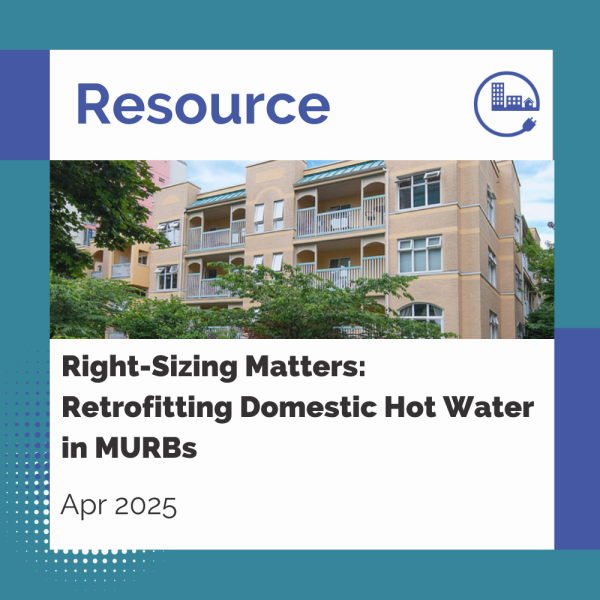
Domestic hot water (DHW) systems can represent 20-25% of the Energy Use Intensity (EUI) and 80-85% of the total Greenhouse Gase Intensity (GHGi) in residential buildings where all other energy uses are electrified (i.e. DHW remains the only natural gas powered system). In Gilford Court, the subject building of this case study, the existing natural gas DHW system accounts for 45% of the total natural gas use, 33% of the total building energy use intensity (EUI) and 44% of the total Greenhouse Gase Intensity (GHGi).
This case study examines the retrofit of the existing domestic hot water (DHW) system in a multi-unit residential building, transitioning from a natural gas-based system to an all-electric DHW heat pump system.
The design philosophy of DHW heat pump systems fundamentally differs from that of fossil-fuel-based DHW systems. While fossil fuel systems are typically designed for high peak output with rapid recovery (minimal storage), heat pump systems prioritize thermal storage over thermal output capacity. Focusing on DHW storage is advantageous as this reduces the size of the heat pump, the most expensive component of the system. This design approach also presents opportunities for load shifting and demand response scenarios, which will become increasingly important as more organizations decarbonize via electrification (i.e. replace fossil fuel-based systems with electric systems).
New sizing tools have emerged alongside the development of DHW heat pumps to support designers. Ecotope Inc. is leading the way and has developed a free online sizing tool called the Ecosizer application, specifically designed for sizing DHW heat pumps in Multi-Unit Residential Buildings (MURBs) and commercial buildings. The tool uses a pre-built load shape developed from measured data from existing multifamily buildings. However, the software also offers the flexibility to tailor the load shape using either measured data or default assumptions from ASHRAE.
This study compares two sizing approaches and the impact on system design, as well as the underlying DHW consumption assumptions:
-
Traditional methodologies (ASHRAE/ASPE) developed for fossil fuel systems.
-
Modern methodologies using software designed for DHW heat pump sizing
-
Based on default assumptions for DHW consumption (gallons/per/day)
-
Based on measured DHW consumption (gallons/per/day)
-
Through these worked examples, the case study highlights the importance of using sizing methodologies specifically designed for domestic hot water heat pumps and the value of measured data in optimizing system cost-effectiveness.
Existing System
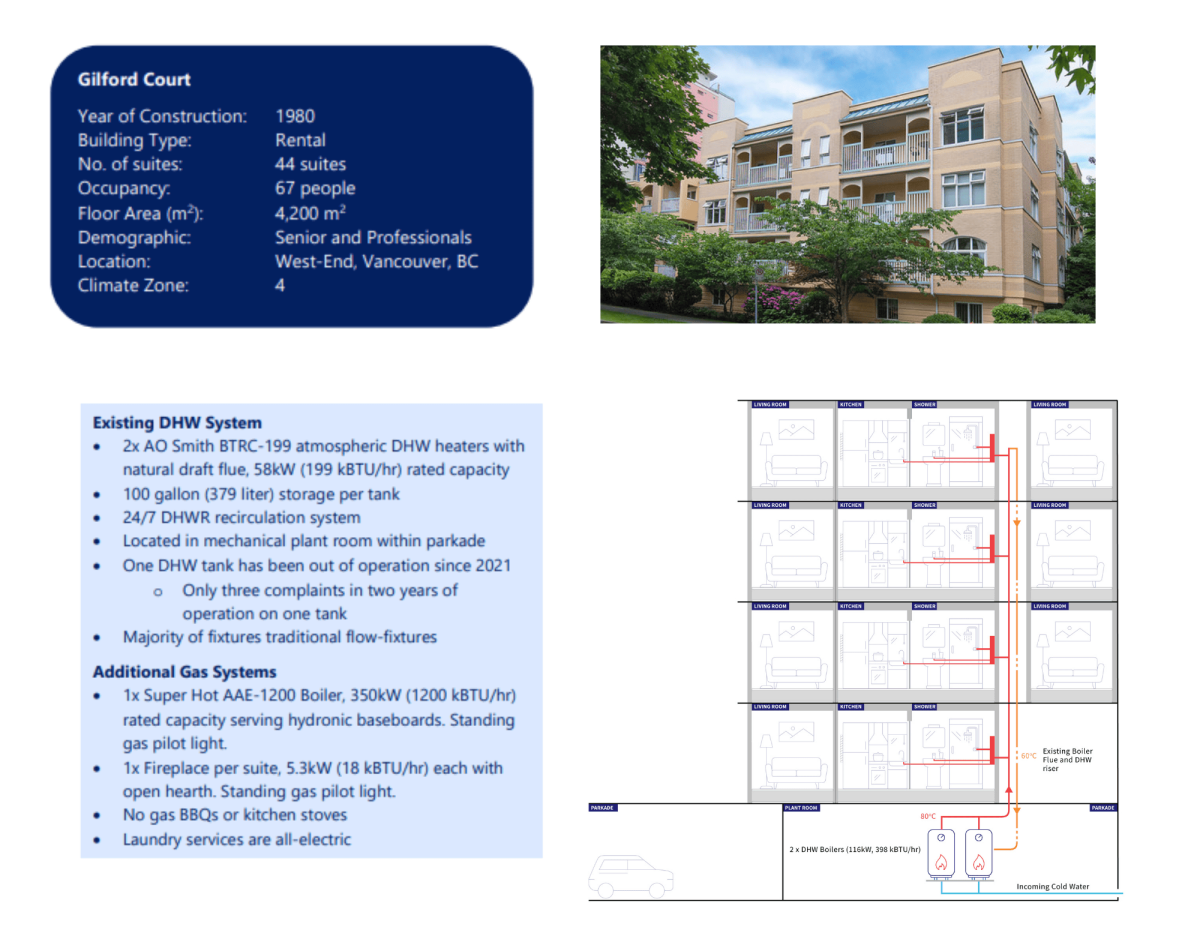

Table 1: Energy Use Intensity (EUI) and Greenhouse Gas Intensity (GHGI) for Gilford Court

Table 2: Comparison of Occupancy Rate Assumptions
From an occupancy density perspective, Ecosizer follows ASHRAE standards or allows users to define their values.
Building Occupancy and Demographic
-
Gilford Court has a mix of one- and two-bedroom apartments housing a total of 67 residents.
-
The majority of occupants are retired seniors (66%), with some older working professionals.
-
The actual occupancy is much lower than that estimated using ASHRAE occupant density assumptions as shown in Table 2. Ecotope’s Ecosizer follows ASHRAE standards or allows users to define their values.
-
Understanding the actual occupancy is important, as these assumptions directly inform system sizing for DHW heat pump systems.
-
Equally understanding the demographic of the building occupants is critical to right-sizing DHW systems, as different groups present different water use behavioural patterns. Seniors typically have a significantly lower DHW consumption than other demographics.
-
Several studies have examined the behavioural patterns of different demographics in relation to energy conservation and water use. Various factors influence these patterns, including age, the presence of children, whether individuals pay for their water consumption and homeownership status. For example, a Canadian Mortgage and Housing Corporation study found that apartment buildings housing families consumed 44% more water per suite than senior's buildings. This finding is related to a higher occupant density in addition to behavioural patterns, such as longer showers.
Measured Data
For retrofit projects, measuring domestic hot water (DHW) consumption is a critical step to inform the system design. Accurate consumption data helps optimize system sizing, improve efficiency, and enhance cost-effectiveness, ensuring the new system meets demand without unnecessary oversizing.
Real-time domestic hot water (DHW) consumption data was collected from Gilford Court over a three-week period in October 2024 using an Onicon F-4400 flow meter supplied by RIADA Sales. A second measurement period was conducted in March 2025 over a two week period to validate the consumption patterns observed in the initial study using a different newly calibrated meter, as the original numbers were quite low.
Both measurement periods were relatively short, as this study was constrained by the time available and the cost of renting the flow meter. It is recommended that real-time DHW consumption be monitored for at least three months, preferably 3–6 months.
The setup for each measurement period included commissioning to ensure accurate data capture. The graphs below (Figure 1, Figure 2) present the consumption data measured over each period. The peak day, Sunday, October 13th coincided with Canadian Thanksgiving. Over the monitoring periods, the average consumption was 5-6 gallons per person per day, with a peak consumption of 12 gallons per person. The peak hourly draw observed from the data on the peak day was 92 gallons per hour, this measurement is critical to sizing the storage requirements for the DHW system.
During the March measurement period, losses in the distribution system were also recorded. The DHW losses were found to align with the Ecosizer assumption of 100 watts per apartment. Distribution losses will remain with a new heat pump system unless the distribution system is replaced as part of the retrofit. The following section explores losses in more detail.
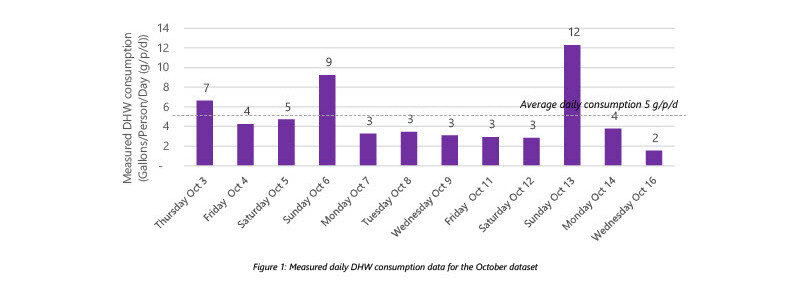
Figure 1: Measured daily DHW consumption data for the October dataset

Figure 2: Measured daily DHW consumption data for the March dataset

Table 3: Measured DHW consumption data
Key Takeaway #1: The measured DHW consumption data for the case study building is significantly lower than the ASHRAE assumptions for DHW consumption used in sizing traditional fossil fuel systems, as well as the default daily consumption value used in Ecosizer, refer to Table 4. It is likely the measured peak DHW consumption is lower than the reference City of Vancouver study, due to the building having a low occupant density and senior demographic. Understanding the actual DHW consumption is a critical first step to sizing the new system.

Table 4: Range of DHW Consumption Assumptions
Domestic Hot Water Annual Profile
The measured data reflects the DHW consumption during October 2024 and March 2025. DHW patterns vary seasonally, this was discussed in a recent City of Vancouver study exploring measured DHW data from 37 MURBs across Vancouver. The study concluded, among other recommendations, that a seasonal multiplier should be applied to estimated values for DHW consumption assumptions, this is shown in Figure 3. October is noted as having a seasonal factor of 1.0.

Figure 3: DHW Seasonal Multiplier
Engineers often use the lowest measured monthly gas consumption (typically summer months) as a proxy for DHW related gas consumption. An example of this is shown in Figure 4 for Gilford Court, here the lowest measured natural gas consumption (July) has been distributed using the DHW seasonal multiplier, shown in Figure 3, to create an estimated annual DHW natural gas profile.
The actual natural gas associated with DHW is an approximation based on summer-time gas consumption when space heating boilers are off and fireplace use would be unusual behaviour. However, as there are pilot lights on boilers and in-suite fireplaces at Gilford Court, an allowance of 5% of the natural gas consumed in summer was allocated to pilot lights or possible fireplace use on summer cool evenings.

Figure 4: Measured gas consumption for 2023 at Gilford Court and estimated gas consumption associated with the DHW system.
Domestic Hot Water Losses
Summer natural gas consumption should not be directly equated to DHW consumption. A substantial portion of the natural gas use is attributed to losses. In the case of Gilford Court, converting the gas consumption data to DHW consumption values, results in an overestimate of the average daily DHW consumption by a factor of over 5 (estimated daily DHW consumption 27 g/p/day, average daily DHW consumption measured at 5 g/p/day).
DHW losses include:
-
Thermal heat losses in the distribution piping
-
Thermal heat losses in the DHW tanks
-
Losses due to the inefficiency of the plant (e.g. combustion losses).
-
Convection losses associated with atmospheric DHW heaters.
Converting the existing natural gas DHW system to an electric heat pump system removes losses attributed to combustion and convection. Table 5 and Figure 5 below outline the breakdown of thermal energy demand and losses for the existing natural gas atmospheric DHW heaters at Gilford Court and the proposed electric heat pump system.

Table 5: Breakdown of thermal energy demand and losses in the existing natural gas DHW system and proposed electric heat pump system
The case study data highlights the substantial losses associated with the existing natural gas DHW heaters (via combustion and convection losses), representing 64% of the annual DHW natural gas consumption (Figure 5). Transitioning to an electric heat pump system eliminates these losses.
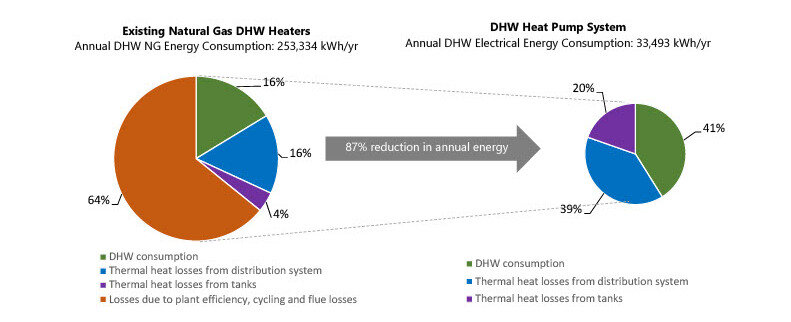
Figure 5: DHW energy consumption for the existing natural gas system compared with the proposed electric heat pump system
Key Takeaway #2: Summer natural gas consumption can be used as a proxy for estimating DHW-related natural gas use, however:
-
A seasonal multiplier (Figure 3) should be applied to generate an annual DHW profile
-
Summer natural gas consumption should not be directly equated to DHW consumption, as it includes energy attributed to losses within the system, which can be substantial (84%).
-
Converting natural gas utility data to estimate DHW consumption, without accounting for these losses will lead to significantly oversized heat pump systems that are neither practical nor cost-effective.
Transitioning to a heat pump system presents the opportunity to reduce annual DHW energy by over 80%.
Key Takeaway #3: It is best practice to measure not only the DHW consumption but also the distribution losses during the measurement period to provide critical insight into the existing losses and where these are attributed within the system.
Sizing the New DHW Heat Pump System
Table 6 compares different sizing approaches using the Ecosizer tool versus traditional ASHRAE/ASPE methodologies and examines the impact of underlying DHW consumption assumptions. The latter method significantly oversized the system, resulting in a heating output three times larger than the Ecosizer default selection.
The recommendation for Gilford Court is to use 16 g/p/day, a more conservative DHW consumption value compared to the measured consumption data of 12 g/p/day, due to the relatively short measurement period. This consumption value aligns with the measured DHW consumption data referenced in the City of Vancouver study. If the occupancy density of Gilford Court increases in the future, or the demographic changes, additional heat pumps and DHW tanks would be required as shown in option 3 in Table 6.
Table 6 highlights the significant differences in system design across sizing methodologies. The study underscores the importance of selecting sizing methodologies designed specifically for DHW heat pump systems and optimizing cost-effectiveness by incorporating real-time DHW consumption data for each project.
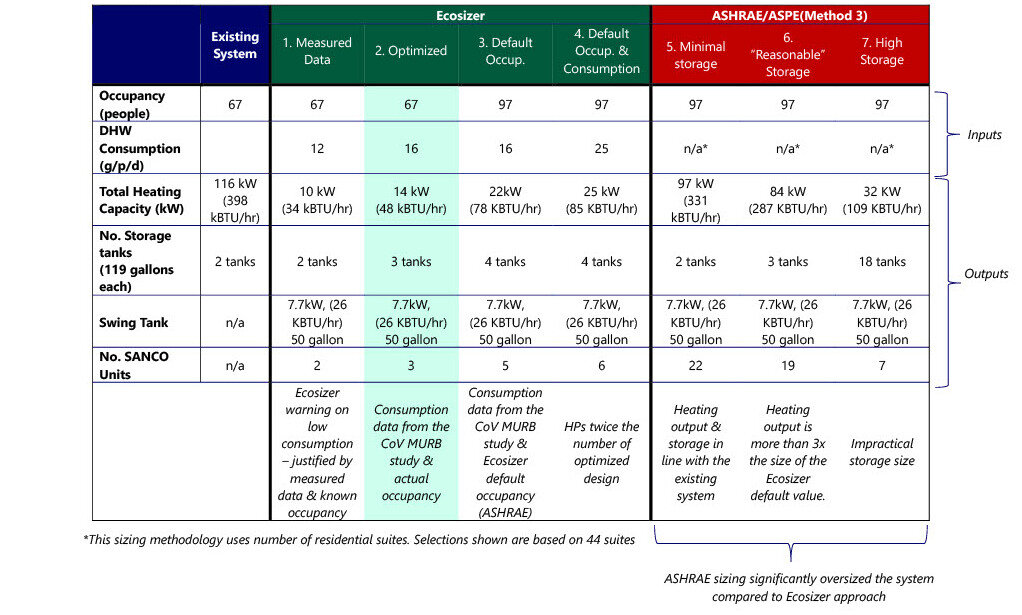
Table 6: Comparison of different design solutions
Design Schematics
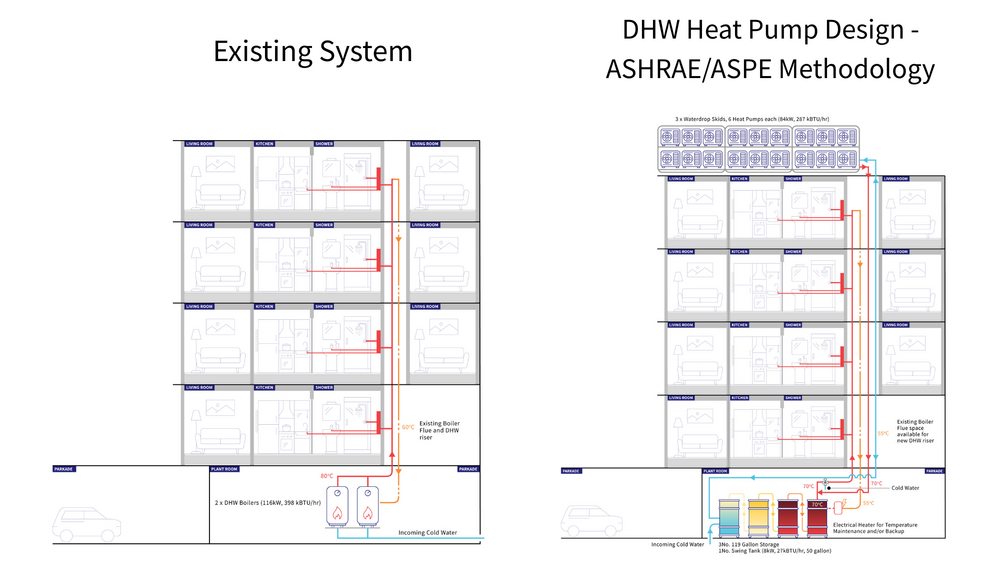

Energy, Emissions and Financial Analysis
The following section explores the estimated energy, emissions and financial performance of the different system designs considered. Table 7 presents two options for the location of the new system – within the parkade or on the roof, with the rooftop option carrying an estimated premium of $30,000. A lifecycle cost analysis was completed to explore the Net Present Cost (NPC) over a 25-year analysis period.
Key Takeaways from the energy, emissions and costing analysis:
-
Correctly sized and designed DHW heat pump systems are cost-effective, presenting only a 1% increase in NPC compared to the Business-As-Usual scenario (replace like-for-similar) over a 25-year analysis period.
-
DHW Heat pump systems are significantly more efficient, reducing DHW-related energy consumption by 87%.
-
The heat pump systems are expected to reduce annual operating costs by almost 60%.
-
The heat pump systems are projected to cut annual and cumulative emissions by 99%.
-
-
Traditional DHW sizing methodologies significantly oversize heat pump systems leading to more than 70% increase in capital costs.
-
Retrofitting the existing natural gas DHW system to a heat pump system reduces the total building EUI by almost 30% and the total building GHGi by 44%.

Table 7: Cost impact summary for different system designs
*Based on estimated electricity rate $0.13/kWh, natural gas rate $0.04/kWh, Carbon tax has not been included. The cost of carbon under the previous provincial carbon tax scheme was $95/tCO2e.

Table 8: Guilford Court Energy Use Intensity (EUI) and Greenhouse Gas Intensity (GHGi) by building system for the existing natural gas DHW system and DHW heat pump system
Key Takeaways
-
Metering is essential for accurate system sizing in retrofit projects. It is best practice to meter DHW consumption for a minimum period of 3 months, preferably 3-6 months. During the metering process distribution losses should also be recorded.
-
The measured DHW consumption data should inform the sizing of the new DHW heat pump system, to ensure cost-effective systems.
-
DHW heat pump systems should be sized using sizing methodologies developed specifically for DHW heat pumps e.g. Ecosizer. Traditional sizing methodologies (e.g. ASHRAE/ASPE) result in significantly oversized DHW systems resulting in a 74% increase in capital costs.
-
Natural gas consumption data in the summer months is not a reliable proxy for DHW demand (g/p/day). The energy consumption includes significant losses associated with the efficiency of the natural gas plant and heat losses throughout the distribution system and therefore if used to calculate DHW consumption would significantly overestimate the size of the heat pump system.
-
-
Access to rental meters is a barrier to data collection. To improve uptake, the province and/or BC Hydro could consider purchasing several meters for various pipe sizes, and establish a loan program for Multi-Unit Residential Buildings considering DHW upgrades. This would allow for 3–6 months of data collection before making heat pump sizing decisions.
-
The study highlights an opportunity for other MURBs to cost-effectively decarbonize by retrofitting their existing natural gas domestic hot water (DHW) systems with electric heat pump technology, resulting in a compelling 44% reduction in total building greenhouse gas intensity (GHGi).
A B2E publication written by Introba, and supported by BC Hydro.
Authors: Harriet Lilley, Stuart Hood P.Eng and Manuel Melo P.L.Eng
 b2e@zeic.ca
b2e@zeic.ca


